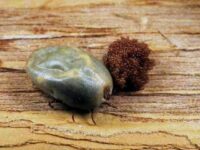The tick population has witnessed a tremendous explosion in the United States over the past two decades, as have a plethora of myths with it! Some people believe that pests tend to follow the scent of blood, or they fall off the trees. All myths, but how do ticks find a host? Well, they can smell really good, see a tiny bit, feel vibrations, body heat, and moisture.
How Do Ticks Find A Host
Ticks find a host using senses tuned to olfactory stimuli, body heat, moisture, light to dark light change, and vibration. With the help of these senses, they notice when a host is approaching.
Most ticks species lie in wait for a host in a position known as “questing“. They crawl up and then hold onto the blades of grass or low shrubs and bushes with their hind legs. The front limbs keep waving in the air, and help the tick to detect a potential host passing by!
Few are hunters, which means those ticks actively crawl around in search of a victim, the brown dog tick is one such hunter.
Can ticks smell?
Yes, ticks can smell. In fact, smell and noticing minute changes and traces of odor in their environment is one of the most important senses that help ticks find a suitable victim. Ticks use their Haller organ to smell and find a host. This is a chemoreceptor on their front legs. With its sensory cells, the tick can smell substances such as ammonia, carbon dioxide, lactic acid, and butyric acid, metabolic products that are released by the host animals through breath and sweat.
Do ticks have eyes?
A few tick species do possess simple eyes, but these are not real eyes as we know it, rather simple light-sensitive cells with which the ticks can perceive the outlines and light and shadows. These can be found on the front part, at the head end of the tick body. Nonetheless, their photoreceptors aren’t really that good at spotting a victim and thus don’t assist much in host-seeking behavior.
Ticks smell body odor, sense heat, and detect favorable environmental cues using Haller’s organ!
The Tick’s Super Sense – Haller’s Organ
Haller’s organ is the tick’s most important tool for perceiving and recognizing a potential victim. Let’s take it as an alternative to an insect’s antenna. It is a tiny sensory structure that sits exclusively on the foreleg – does the waving part make sense now?
Ticks utilize it to catch the source of carbon dioxide, ammonia, and pheromones. Furthermore, it can detect changes in humidity when a victim approaches and also senses changes in temperature caused by a warm-blooded host in the area. In reality, ticks are equipped with true super senses for host recognition.
Ticks sense body heat, odor, moisture, certain chemicals, and vibrations but not the scent of blood.
Further research on the quantitative and qualitative features of Haller’s organs is required to determine their relation to disease transmission. Recently, three experts delved in to spot crucial morphological differences across species and gender.
Recorded in the Journal of Medical Entomology, this study involved medically important species of black-legged, lone star, and American dog ticks.
How does tick repellent work?
All tick repellents or insect repellents work on a similar principle. A repellent disrupts the parasite’s sensory organs, making it difficult to identify a suitable host
All certified insect repellents are effective but not the same!
A strong repellent scrambles the reception apparatus of ticks. It doesn’t ward them off by killing or blocking stimulus. Instead, it disorients the metabolic and olfactory mechanisms of Haller’s organ.
As a result, ticks have a hard time finding their next victim – meanwhile, you and your loved ones!
Insect repellents – are they effective?
Safe and strong personal repellents, along with permethrin-treated garments, make a reliable first line of defense in a tick-infested oasis.
Any form of wearable device advertised for protection against biting insects is known as a repellent. However, their chemical agents, target species, and potency ratio differ.
There are numerous repellents, ranging from spray-on and lotions to oral medications. Experts suggest preferring topical treatment. The key differentiator is the active ingredient used in such formulas. Some do their work faithfully; others fail miserably.
List in order of preference the best active ingredients
- DEET
- Picaridin
- Lemon Eucalyptus Oil
- IR3535
DEET and Picaridin are chemical-based repellents proven to provide broad-spectrum protection. With 20-30% concentration, they offer long-term and fool-proof security against tick threats.
Some users may find them allergenic or look for non-synthetic alternatives. In that case, oil of lemon eucalyptus makes a sensible choice. IR3535 is also derived from natural sources. It has shown amazing results that are on par with DEET and Picaridin.
Similarly, most essential oils are not regulated by authorities, thus falling short of their promised effects. Make sure to buy EPA-registered products, read the warnings, and consult a doctor or vet.
More to read on how ticks find a host:
Ticks sensing body heat
https://pubmed.ncbi.nlm.nih.gov/31442282/



